Awareness and Understanding of Climate Change for Environmental Sustainability Using a Mix-Method Approach: A Study in the Kathmandu Valley
Abstract
1. Introduction
2. Literature Review
2.1. Awareness of Climate Change
2.2. Understanding on Causes of Climate Change
2.3. Understanding the Mitigation Measures of Climate Change
2.4. Role of Entities in Tackling Climate Change
3. Methodology
3.1. Research Design
3.2. Instruments and Hypothesis
3.3. Sample and Sampling Method
3.4. Data Analysis
4. Results and Analysis
4.1. Demographics of the Respondents
4.2. Awareness of Climate Change
“The subject EPH, which stands for environment, physical health, and human health, is where I first learned about climate change in the eighth grade.”FGD 1, Participant 1
“I came to know about climate change in my school. Increased pollution, low visibility, and an increase in temperature are caused by the effects of climate change.”FGD 2, Participant 4
4.3. Understanding of Climate Change
“Unpredictable seasonal patterns; for example, last year’s April snowfall is unusual.”FGD 3, Participant 2
“Climate change leads to an increase in new diseases like COVID-19. Inadequate waste management and population growth lead to the emergence of several diseases, some of which may be new variants of existing diseases.”FGD 3, Participant 1
4.4. Causes of Climate Change
“I think due to the increase of vehicles each year, we are facing a lot of air and sound pollution.”FGD 2, Participant 1
“Deforestation and dumping waste in the river affects climate change. In the past, my family members including my mom, dad, and uncle used to enjoy bathing in the Bishnumati River. However, due to climate change and pollution, the river’s water has become so dirty that we can no longer use it for any purpose.”FGD 4, Participant 4
4.5. Mitigation Measures for Climate Change
“In my opinion to reduce the impact of climate change, we must start working from our house. We can reduce the use of plastic and segregate the waste. People should be strictly informed not to mix all the waste from the latrine to the nearby river or stream.”FGD 3, Participants 1
“The government should be vigilant and enact laws to lessen industrial pollution since large enterprises pollute the air and dump dangerous chemicals into adjacent streams and rivers. Dumping sites must be managed properly so that the waste can’t pollute the air and nearby communities which ultimately brings a lot of harmful diseases that will directly affect the human population.”FGD 4, Participants 4
4.6. Greenhouse Gases Affecting Climate Change
“I believe that the greenhouse is having a variety of negative effects, resulting in climate change. More and more ultraviolet radiation is entering the greenhouse, and we are seeing an increasing number of skin-related issues.”FGD 3, Participants 2
4.7. Accountable and Responsible for Climate Change
“International industrialized countries are accountable for climate change, these countries are more responsible as they are testing new things for experiments like atomic bombs, missiles, etc. which are the activities that account for climate change.”FGD 1, Participants 2
“The individuals are accountable for climate change, we use plastic-related products and forget to bring our bags when we go shopping. Products made of plastic are now an essential part of our lives. Until and unless we stop using plastic products, we should be held accountable for climate change.”FGD 3, Participants 1
“I think the government is responsible. The government should take demanding steps to reduce the infectious gas or chemicals from the industry. Government should prioritize more on electric vehicles and renewable energy. Old cars and buses should be checked for how much gas they emit each day and made accountable.”FGD 2, Participants 1
“We as an individual are also responsible as we can contribute to various activities inside and outside our home to tackle climate change.”FGD 1, Participants 2
4.8. Addressing Climate Change: Role
“I believe the government can help reduce population density in major cities by providing equal opportunities in rural areas, such as access to education, healthcare, and jobs. This would encourage people to remain in their hometowns, ultimately decreasing urban population pressures and addressing issues like pollution, waste management, and the loss of fertile agricultural land to urban development.”FGD 1, Participants 3
“The government has to make strict policies to reduce petroleum vehicles and promote electric vehicles. The government has to emphasize renewable energy.”FGD 3, Participants 4
“We as an individual can contribute to reducing the impact of climate change from our home itself by segregating the waste as disposal and non-disposal. We can make a compost organic fertilizer from the disposal waste from the kitchen and use it in kitchen gardening. The community should also work towards waste management.”FGD 2, Participants 2
4.9. Climate Change: Media Preferences
5. Conclusions
Author Contributions
Funding
Institutional Review Board Statement
Informed Consent Statement
Data Availability Statement
Conflicts of Interest
References
- Huang, M.; Ding, L.; Wang, J.; Ding, C.; Tao, J. The impacts of climate change on fish growth: A summary of conducted studies and current knowledge. Ecol. Indic. 2021, 121, 106976. [Google Scholar] [CrossRef]
- Tol, R.S. Estimates of the damage costs of climate change. Part 1: Benchmark estimates. Environ. Resour. Econ. 2002, 21, 47–73. [Google Scholar] [CrossRef]
- Dellink, R.; Lanzi, E.; Chateau, J. The sectoral and regional economic consequences of climate change to 2060. Environ. Resour. Econ. 2019, 72, 309–363. [Google Scholar] [CrossRef]
- Colette, A. Climate Change and World Heritage: Report on Predicting and Managing the Impacts of Climate Change on World Heritage and Strategy to Assist States Parties to Implement Appropriate Management Responses; Unesco World Heritage Centre: Paris, France, 2007. [Google Scholar]
- Jayawardhan, S. Vulnerability and climate change induced human displacement. Consilience 2017, 17, 103–142. [Google Scholar]
- Rahmani, F.; Fattahi, M.H. Investigation of alterations in droughts and floods patterns induced by climate change. Acta Geophys. 2024, 72, 405–418. [Google Scholar] [CrossRef]
- Rawat, A.; Kumar, D.; Khati, B.S. A review on climate change impacts, models, and its consequences on different sectors: A systematic approach. J. Water Clim. Chang. 2024, 15, 104–126. [Google Scholar] [CrossRef]
- Dagnachew, A.G.; Hof, A.; Soest, H.V.; Vuuren, D. Climate Change Measures and Sustainable Development Goals; PBL Netherlands Environmental Assessment Agency: The Hague, The Netherlands, 2021. [Google Scholar]
- Bansard, J.; Akanle Eni-ibukun, T.; Allan, J.; Bertram, D.; Dubrova, A.; Luomi, M. Earth Negotiations Bulletin: Summary of the 2024 Baku Climate Change Conference. In Proceedings of the 2024 Baku Climate Change Conference, Baku, Azerbaijan, 11–22 November 2024; Available online: https://enb.iisd.org/baku-un-climate-change-conference-cop29 (accessed on 12 January 2025).
- Upadhyay, B.; Bastola, A. Breaking the silence: The complex nexus of gender and climate change in Nepal. Environ. Res. Clim. 2024, 3, 025004. [Google Scholar] [CrossRef]
- Bank, W. Nepal Country Climate and Development Report 2022; CCDR Series; © World Bank: Washington, DC, USA, 2022; License: CC BY-NC-ND. [Google Scholar]
- Uprety, S.K.; Chhetri, R.P. Adopting a Low-Emission and Climate-Resilient Development Pathway in Nepal; Prakriti Resources Centre: Kathmandu, Nepal, 2024. [Google Scholar]
- Gentle, P.; Mainaly, J. Commitment, actions, and challenges on locally led climate change adaptation in Nepal. Clim. Risk Manag. 2024, 46, 100650. [Google Scholar] [CrossRef]
- Rehman, T.; Bandh, S.; Peerzada, M.; Bashir, S.; Hoang, A. Knowledge, perception and attitude in relation to climate change: A cross-sectional survey. Environ. Sci. 2021, preprint. [Google Scholar] [CrossRef]
- Suman, A. Role of renewable energy technologies in climate change adaptation and mitigation: A brief review from Nepal. Renew. Sustain. Energy Rev. 2021, 151, 111524. [Google Scholar] [CrossRef]
- Dahal, P.; Shrestha, M.L.; Panthi, J.; Pradhananga, D. Modeling the future impacts of climate change on water availability in the Karnali River Basin of Nepal Himalaya. Environ. Res. 2020, 185, 109430. [Google Scholar] [CrossRef] [PubMed]
- Rayamajhee, V.; Guo, W.; Bohara, A.K. The impact of climate change on rice production in Nepal. Econ. Disasters Clim. Chang. 2021, 5, 111–134. [Google Scholar] [CrossRef]
- Sullivan, A.; White, D.D. Climate change as catastrophe or opportunity? Climate change framing and implications for water and climate governance in a drought-prone region. J. Environ. Stud. Sci. 2020, 10, 1–11. [Google Scholar] [CrossRef]
- de Rivas, R.; Vilches, A.; Mayoral, O. Secondary School Students’ Perceptions and Concerns on Sustainability and Climate Change. Climate 2024, 12, 17. [Google Scholar] [CrossRef]
- Almusalami, A.; Alnaqbi, F.; Alkaabi, S.; Alzeyoudi, R.; Awad, M. Sustainability Awareness in the UAE: A Case Study. Sustainability 2024, 16, 1621. [Google Scholar] [CrossRef]
- Abbas, A.; Ekowati, D.; Suhariadi, F.; Fenitra, R.M. Health implications, leaders societies, and climate change: A global review. In Ecological Footprints of Climate Change: Adaptive Approaches and Sustainability; Springer: Berlin/Heidelberg, Germany, 2023; pp. 653–675. [Google Scholar]
- Jang, H.W.; Yoo, J.J.E.; Cho, M. Resistance to blockchain adoption in the foodservice industry: Moderating roles of public pressures and climate change awareness. Int. J. Contemp. Hosp. Manag. 2024, 36, 1467–1489. [Google Scholar] [CrossRef]
- Ofori, B.Y.; Ameade, E.P.; Ohemeng, F.; Musah, Y.; Quartey, J.K.; Owusu, E.H. Climate change knowledge, attitude and perception of undergraduate students in Ghana. PLoS Clim. 2023, 2, e0000215. [Google Scholar] [CrossRef]
- Mebane, M.E.; Benedetti, M.; Barni, D.; Francescato, D. Promoting climate change awareness with high school students for a sustainable community. Sustainability 2023, 15, 11260. [Google Scholar] [CrossRef]
- Gautam, B.; Mandal, P.K.; Yangden, N. Students’ awareness towards climate change: A study of climate change effects on human health in Nepal. Prithvi Acad. J. 2021, 4, 18–26. [Google Scholar] [CrossRef]
- Adhikari, S.; Rawal, S.; Thapa, S. Assessment of Status of Climate Change and Determinants of People’s Awareness to Climate-Smart Agriculture: A Case of Sarlahi District, Nepal. Adv. Agric. 2022, 2022, 1556407. [Google Scholar] [CrossRef]
- Sullivan, A.; White, D.D. An assessment of public perceptions of climate change risk in three western US cities. Weather Clim. Soc. 2019, 11, 449–463. [Google Scholar] [CrossRef]
- Litke, N.A.; Poß-Doering, R.; Fehrer, V.; Köppen, M.; Kümmel, S.; Szecsenyi, J.; Wensing, M. Building climate resilience: Awareness of climate change adaptation in German outpatient medical practices. BMC Health Serv. Res. 2024, 24, 184. [Google Scholar]
- Saari, U.A.; Damberg, S.; Frömbling, L.; Ringle, C.M. Sustainable consumption behavior of Europeans: The influence of environmental knowledge and risk perception on environmental concern and behavioral intention. Ecol. Econ. 2021, 189, 107155. [Google Scholar]
- Bouman, T.; Verschoor, M.; Albers, C.J.; Böhm, G.; Fisher, S.D.; Poortinga, W.; Whitmarsh, L.; Steg, L. When worry about climate change leads to climate action: How values, worry and personal responsibility relate to various climate actions. Glob. Environ. Chang. 2020, 62, 102061. [Google Scholar]
- Barreda, A.B. Assessing the level of awareness on climate change and sustainable development among students of Partido State University, Camarines Sur, Philippines. J. Sustain. Educ. 2018, 17, 1–17. [Google Scholar]
- Taylor, A.; de Bruin, W.B.; Dessai, S. Climate change beliefs and perceptions of weather-related changes in the United Kingdom. Risk Anal. 2014, 34, 1995–2004. [Google Scholar] [CrossRef]
- Fairbrother, M. Public opinion about climate policies: A review and call for more studies of what people want. PLoS Clim. 2022, 1, e0000030. [Google Scholar]
- Calculli, C.; D’Uggento, A.M.; Labarile, A.; Ribecco, N. Evaluating people’s awareness about climate changes and environmental issues: A case study. J. Clean. Prod. 2021, 324, 129244. [Google Scholar] [CrossRef]
- Poortinga, W.; Demski, C.; Steentjes, K. Generational differences in climate-related beliefs, risk perceptions and emotions in the UK. Commun. Earth Environ. 2023, 4, 229. [Google Scholar]
- Fagan, M.; Huang, C. A Look at How People Around the World View Climate Change. 2019. Available online: https://www.pewresearch.org/short-reads/2019/04/18/a-look-at-how-people-around-the-world-view-climate-change/ (accessed on 20 January 2025).
- Bord, R.; O’Connor, R.; Fisher, A. In What Sense Does the Public Need to Understand Global Climate Change? Public Underst. Sci. 2000, 9, 205–218. [Google Scholar] [CrossRef]
- Raimi, K.T.; Sarge, M.A.; Geiger, N.; Gillis, A.; Cunningham, J.L. Effects of communicating the rise of climate migration on public perceptions of climate change and migration. J. Environ. Psychol. 2024, 93, 102210. [Google Scholar] [CrossRef]
- Baum, C.M.; Fritz, L.; Low, S.; Sovacool, B.K. Public perceptions and support of climate intervention technologies across the Global North and Global South. Nat. Commun. 2024, 15, 2060. [Google Scholar] [CrossRef]
- Sebos, I.; Nydrioti, I.; Katsiardi, P.; Assimacopoulos, D. Stakeholder perceptions on climate change impacts and adaptation actions in Greece. Euro. Mediterr. J. Environ. Integr. 2023, 8, 777–793. [Google Scholar] [CrossRef]
- Baldwin, C.; Pickering, G.; Dale, G. Knowledge and self-efficacy of youth to take action on climate change. Environ. Educ. Res. 2023, 29, 1597–1616. [Google Scholar] [CrossRef]
- Hazarika, A.; Nath, A.J.; Pandey, R.; Pebam, R.; Devi, N.B.; Das, A.K. Climate change vulnerability of tribe managing Piper agroforestry systems in the Indian sub-Himalayan region. Agric. Syst. 2024, 216, 103914. [Google Scholar] [CrossRef]
- Gabric, A.J. The Climate Change Crisis: A Review of Its Causes and Possible Responses. Atmosphere 2023, 14, 1081. [Google Scholar] [CrossRef]
- Steiner, A.K.; Engdaw, M.M. Climate Change, Its Impacts, and Attribution of Causes: Current Status and Challenges; Nomos: Baden-Baden, Germany, 2022; pp. 21–40. [Google Scholar]
- Kabir, M.I.; Rahman, M.B.; Smith, W.; Lusha, M.A.F.; Azim, S.; Milton, A.H. Knowledge and perception about climate change and human health: Findings from a baseline survey among vulnerable communities in Bangladesh. BMC Public Health 2016, 16, 266. [Google Scholar] [CrossRef]
- Kamaruddin, S.A.; Adnan, F.R.; Anuar, M.H.; Saiffullah Asrif, I.; Zulkefle, M.M.; Aiman Azaha, M.N.; Ahmad, M.N.; Arshad, M. Assessment of knowledge, perception, and attitude towards causes related to climate change among the undergraduates of the non-science students of Universiti Teknologi MARA, Perlis branch. J. Intelek 2022, 17, 236–245. [Google Scholar] [CrossRef]
- Kyriakopoulos, G.L.; Sebos, I. Enhancing climate neutrality and resilience through coordinated climate action: Review of the synergies between mitigation and adaptation actions. Climate 2023, 11, 105. [Google Scholar] [CrossRef]
- Akompab, D.A.; Bi, P.; Williams, S.; Grant, J.; Walker, I.A.; Augoustinos, M. Awareness of and attitudes towards heat waves within the context of climate change among a cohort of residents in Adelaide, Australia. Int. J. Environ. Res. Public Health 2013, 10, 1–17. [Google Scholar] [CrossRef]
- Mani, Z.A.; Goniewicz, K. Adapting disaster preparedness strategies to changing climate patterns in Saudi Arabia: A rapid review. Sustainability 2023, 15, 14279. [Google Scholar] [CrossRef]
- Miripanah, Z.; Tavakoli, M.; Rostaminya, M.; Naderi, M. Carbon sequestration via afforestation as a sustainable action to mitigate climate change in Western Iran. In Natural Resources Forum; Wiley Online Library: Hoboken, NJ, USA, 2019; Volume 43, pp. 194–202. [Google Scholar]
- Yang, L.; Liao, W.; Liu, C.; Zhang, N.; Zhong, S.; Huang, C. Associations between knowledge of the causes and perceived impacts of climate change: A cross-sectional survey of medical, public health and nursing students in universities in China. Int. J. Environ. Res. Public Health 2018, 15, 2650. [Google Scholar] [CrossRef]
- Akrofi, M.M.; Antwi, S.H.; Gumbo, J.R. Students in climate action: A study of some influential factors and implications of knowledge gaps in Africa. Environments 2019, 6, 12. [Google Scholar] [CrossRef]
- Mostafa, M.M. Egyptian consumers’ willingness to pay for carbon-labeled products: A contingent valuation analysis of socio-economic factors. J. Clean. Prod. 2016, 135, 821–828. [Google Scholar]
- Chowdhury, M.M.I.; Rahman, S.M.; Abubakar, I.R.; Aina, Y.A.; Hasan, M.A.; Khondaker, A. A review of policies and initiatives for climate change mitigation and environmental sustainability in Bangladesh. Environ. Dev. Sustain. 2021, 23, 1133–1161. [Google Scholar] [CrossRef]
- Farbotko, C.; Boas, I.; Dahm, R.; Kitara, T.; Lusama, T.; Tanielu, T. Reclaiming open climate adaptation futures. Nat. Clim. Change 2023, 13, 750–751. [Google Scholar]
- Davidson, J.P.; Kemp, L. Climate catastrophe: The value of envisioning the worst-case scenarios of climate change. Wiley Interdiscip. Rev. Clim. Change 2024, 15, e871. [Google Scholar]
- Regnault, A.; Willgoss, T.; Barbic, S. Towards the use of mixed methods inquiry as best practice in health outcomes research. J. Patient Rep. Outcomes 2018, 2, 19. [Google Scholar] [CrossRef] [PubMed]
- Kaur, M. Application of mixed method approach in public health research. Indian J. Community Med. 2016, 41, 93–97. [Google Scholar]
- Creswell, J.W.; Clark, V.L.P. Designing and Conducting Mixed Methods Research; Sage Publications: Thousand Oaks, CA, USA, 2017. [Google Scholar]
- Salem, M.R.; Hegazy, N.; Thabet Mohammed, A.A.; Mahrous Hassan, E.; Saad Abdou, M.M.; Zein, M.M. Climate change-related knowledge and attitudes among a sample of the general population in Egypt. Front. Public Health 2022, 10, 1047301. [Google Scholar]
- Halady, I.R.; Rao, P.H. Does awareness to climate change lead to behavioral change? Int. J. Clim. Change Strateg. Manag. 2010, 2, 6–22. [Google Scholar] [CrossRef]
- Korkmaz, M. Public awareness and perceptions of climate change: Differences in concern about climate change in the West Mediterranean region of Turkey. Appl. Ecol. Environ. Res. 2018, 16, 4039–4050. [Google Scholar] [CrossRef]
- Read, D.; Bostrom, A.; Morgan, M.G.; Fischhoff, B.; Smuts, T. What do people know about global climate change? 2. Survey studies of educated laypeople. Risk Anal. 1994, 14, 971–982. [Google Scholar]
- Paudel, B.; Zhang, Y.; Yan, J.; Rai, R.; Li, L.; Wu, X.; Chapagain, P.S.; Khanal, N.R. Farmers’ understanding of climate change in Nepal Himalayas: Important determinants and implications for developing adaptation strategies. Clim. Change 2020, 158, 485–502. [Google Scholar]
- Teixeira, Z.; Morgado, R.; Marques, C.; Gonçalves, C.; Carvalho, P.; Cunha, A.; Moreira, C. What children know and want to know about climate change: A prior-knowledge self-assessment. Environ. Educ. Res. 2024, 30, 2246–2271. [Google Scholar]
- Abbass, K.; Qasim, M.Z.; Song, H.; Murshed, M.; Mahmood, H.; Younis, I. A review of the global climate change impacts, adaptation, and sustainable mitigation measures. Environ. Sci. Pollut. Res. 2022, 29, 42539–42559. [Google Scholar]
- Slingo, J.; Slingo, M. The science of climate change and the effect of anaesthetic gas emissions. Anaesthesia 2024, 79, 252–260. [Google Scholar] [CrossRef]
- D’amato, G.; Cecchi, L. Effects of climate change on environmental factors in respiratory allergic diseases. Clin. Exp. Allergy 2008, 38, 1264–1274. [Google Scholar] [CrossRef]
- Quayle, B.; Sciulli, N.; Wilson-Evered, E. Accountable to who, to whom, for what and how? Unpacking Accountability in Local Government Response to Climate Change. Australas. Account. Bus. Financ. J. 2020, 14, 56–74. [Google Scholar] [CrossRef]
- Andre, P.; Boneva, T.; Chopra, F.; Falk, A. Globally representative evidence on the actual and perceived support for climate action. Nat. Clim. Chang. 2024, 14, 253–259. [Google Scholar]
- Fortner, R.W.; Lee, J.Y.; Corney, J.R.; Romanello, S.; Bonnell, J.; Luthy, B.; Figuerido, C.; Ntsiko, N. Public understanding of climate change: Certainty and willingness to act. Environ. Educ. Res. 2000, 6, 127–141. [Google Scholar] [CrossRef]
- National Health Research Council. National Ethical Guidelines for Health Research in Nepal 2022; National Health Research Council: Kathmandu, Nepal, 2022.
- Uakarn, C.; Chaokromthong, K.; Sintao, N. Sample size estimation using Yamane and Cochran and Krejcie and Morgan and Green formulas and Cohen statistical power analysis by G* power and comparisons. Apheit Int. J. 2021, 10, 76–88. [Google Scholar]
- Conroy, R.M. The RCSI Sample size handbook. A Rough Guide; Royal College of Surgeons in Ireland: Dublin, Ireland, 2016; pp. 59–61. [Google Scholar]
- Subedi, B.P. Ethnic/caste diversification in Kathmandu metropolitan: Changing social landscape of a capital city. J. Geogr. Reg. Plan. 2010, 3, 185. [Google Scholar]
- Shrestha, D.; Basnyat, D.B.; Gyawali, J.; Creed, M.J.; Sinclair, H.D.; Golding, B.; Muthusamy, M.; Shrestha, S.; Watson, C.S.; Subedi, D.L.; et al. Rainfall extremes under future climate change with implications for urban flood risk in Kathmandu, Nepal. Int. J. Disaster Risk Reduct. 2023, 97, 103997. [Google Scholar]
- National Statistics Office. National Population and Housing Census 2021 (National Report); National Statistics Office: Ramshahpath, Thapathali, Kathmandu, Nepal, 2023.
- Jick, T.D. Mixing qualitative and quantitative methods: Triangulation in action. Adm. Sci. Q. 1979, 24, 602–611. [Google Scholar]
- Shrestha, A. Study of Production Economics and Production Problems of Honey in Bardiya District, Nepal. Sarhad J. Agric. 2018, 34, 225–493. [Google Scholar]
- Lee, K.; Gjersoe, N.; O’neill, S.; Barnett, J. Youth perceptions of climate change: A narrative synthesis. Wiley Interdiscip. Rev. Clim. Change 2020, 11, e641. [Google Scholar]
- Knight, K.W. Public awareness and perception of climate change: A quantitative cross-national study. Environ. Sociol. 2016, 2, 101–113. [Google Scholar]
- Urry, J. Climate change and society. In Why the Social Sciences Matter; Springer: Berlin/Heidelberg, Germany, 2015; pp. 45–59. [Google Scholar]
- Bostrom, A.; Böhm, G.; O’Connor, R.E. Targeting and tailoring climate change communications. Wiley Interdiscip. Rev. Clim. Change 2013, 4, 447–455. [Google Scholar] [CrossRef]
- Brouwer, R.; Akter, S.; Brander, L.; Haque, E. Socioeconomic vulnerability and adaptation to environmental risk: A case study of climate change and flooding in Bangladesh. Risk Anal Int. J. 2007, 27, 313–326. [Google Scholar]
- Koetse, M.J.; Rietveld, P. The impact of climate change and weather on transport: An overview of empirical findings. Transp. Res. Part D Transp. Environ. 2009, 14, 205–221. [Google Scholar] [CrossRef]
- Wang, S.W.; Lee, W.K.; Son, Y. An assessment of climate change impacts and adaptation in South Asian agriculture. Int. J. Clim. Change Strateg. Manag. 2017, 9, 517–534. [Google Scholar] [CrossRef]
- Dhital, Y.; Kayastha, R. Frequency analysis, causes and impacts of flooding in the Bagmati River Basin, Nepal. J. Flood Risk Manag. 2013, 6, 253–260. [Google Scholar] [CrossRef]
- Trenberth, K.E. Climate change caused by human activities is happening and it already has major consequences. J. Energy Nat. Resour. Law 2018, 36, 463–481. [Google Scholar] [CrossRef]
- Chaudhary, R.P.; Uprety, Y.; Rimal, S.K. Deforestation in Nepal: Causes, consequences and responses. Biol. Environ. Hazards Risks Disasters 2016, 12, 335–372. [Google Scholar]
- Van der Linden, S. The social-psychological determinants of climate change risk perceptions: Towards a comprehensive model. J. Environ. Psychol. 2015, 41, 112–124. [Google Scholar] [CrossRef]
- Dasandara, S.; Kulatunga, U.; Ingirige, M.; Fernando, T. Climate change challenges facing Sri Lanka: A literature review. In Proceedings of the 9th World Construction Symposium, Moratuwa, Sri Lanka, 9–10 July 2021; p. 184. [Google Scholar]
- Lutz, W.; Muttarak, R.; Striessnig, E. Universal education is key to enhanced climate adaptation. Science 2014, 346, 1061–1062. [Google Scholar] [CrossRef]
- UNESCO. Climate Change Education 2022; UNESCO: Paris, France, 2022. [Google Scholar]
- Rahman, M.H.; Voumik, L.C.; Akter, S.; Radulescu, M. New insights from selected South Asian countries on the determinants of GHG emissions. Energy Environ. 2025, 36, 958–978. [Google Scholar] [CrossRef]
- Majumder, S.C.; Voumik, L.C.; Rahman, M.H.; Rahman, M.M.; Hossain, M.N. A quantile regression analysis of the impact of electricity production sources on CO2 emission in South Asian Countries. Strateg. Plan. Energy Environ. 2023, 42, 307–330. [Google Scholar] [CrossRef]
- Mirza, M.M.Q. Climate change and extreme weather events: Can developing countries adapt? Clim. Policy 2003, 3, 233–248. [Google Scholar] [CrossRef]
- Laukkonen, J.; Blanco, P.K.; Lenhart, J.; Keiner, M.; Cavric, B.; Kinuthia-Njenga, C. Combining climate change adaptation and mitigation measures at the local level. Habitat Int. 2009, 33, 287–292. [Google Scholar]
- Murali, R.; Kuwar, A.; Nagendra, H. Who’s responsible for climate change? Untangling threads of media discussions in India, Nigeria, Australia, and the USA. Clim. Change 2021, 164, 51. [Google Scholar] [CrossRef]
- Bergquist, M.; Nilsson, A.; Schultz, W.P. A meta-analysis of field-experiments using social norms to promote pro-environmental behaviors. Glob. Environ. Change 2019, 59, 101941. [Google Scholar]
- Maki, A.; Burns, R.J.; Ha, L.; Rothman, A.J. Paying people to protect the environment: A metaanalysis of financial incentive interventions to promote proenvironmental behaviors. J. Environ. Psychol. 2016, 47, 242–255. [Google Scholar]
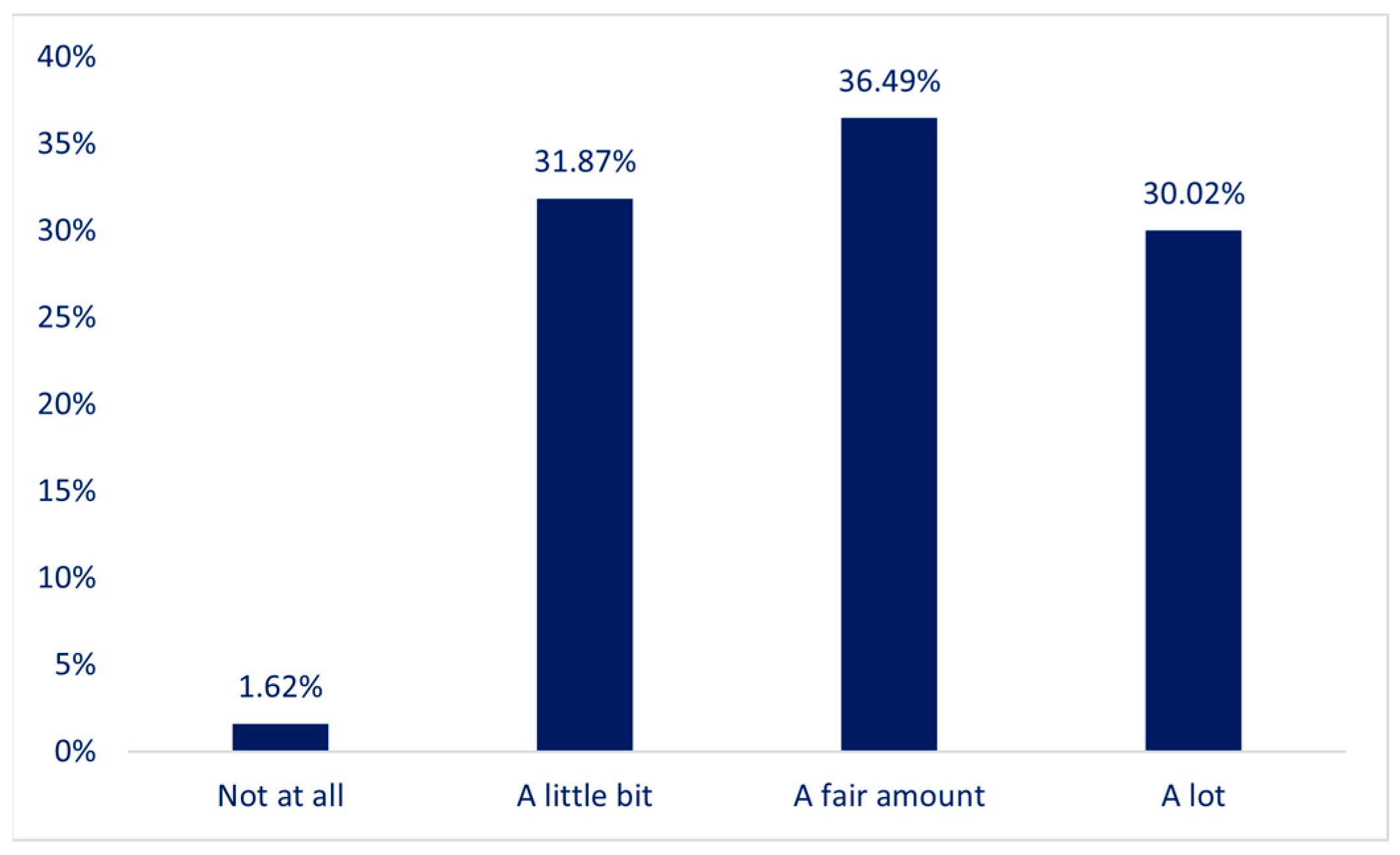
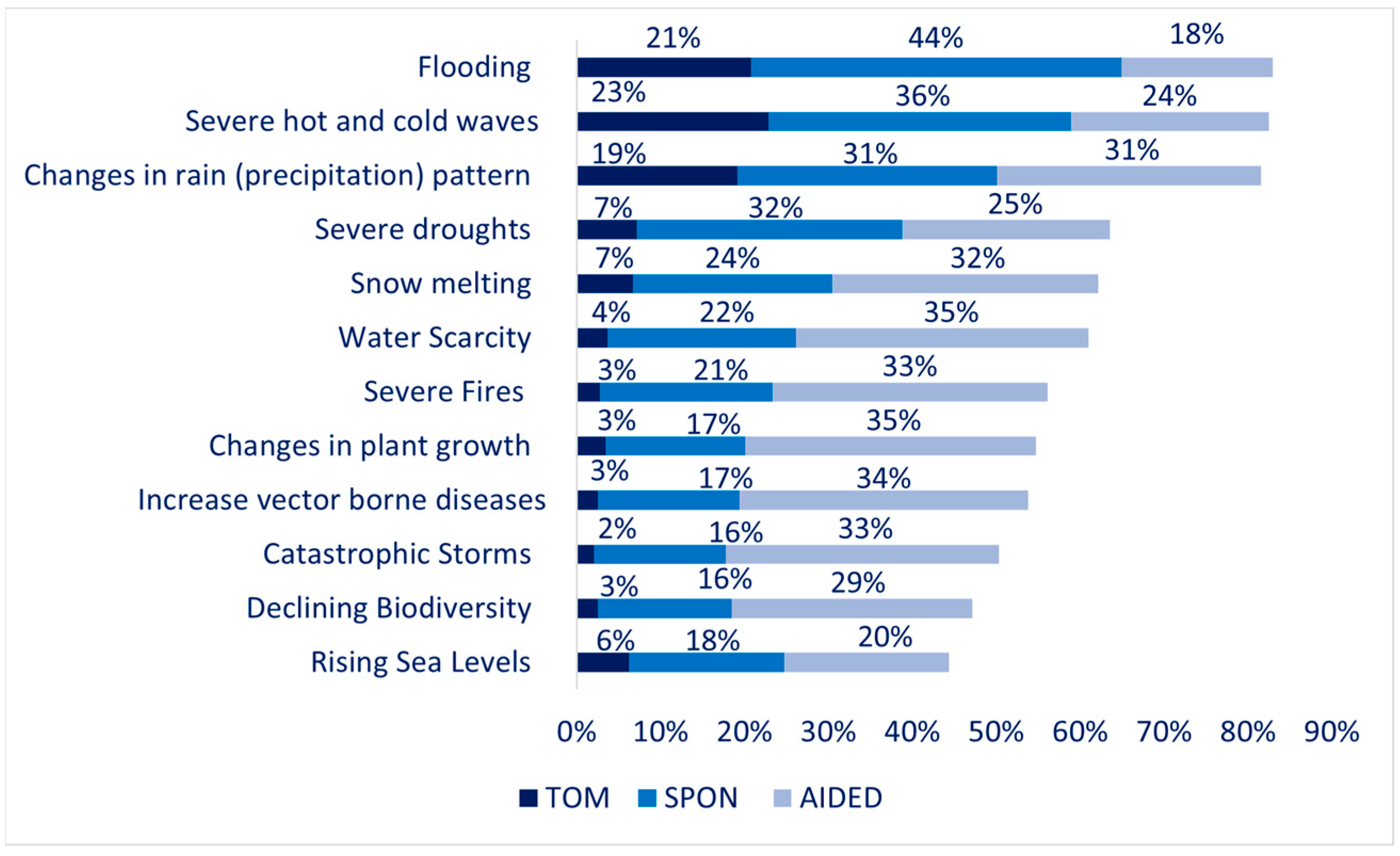
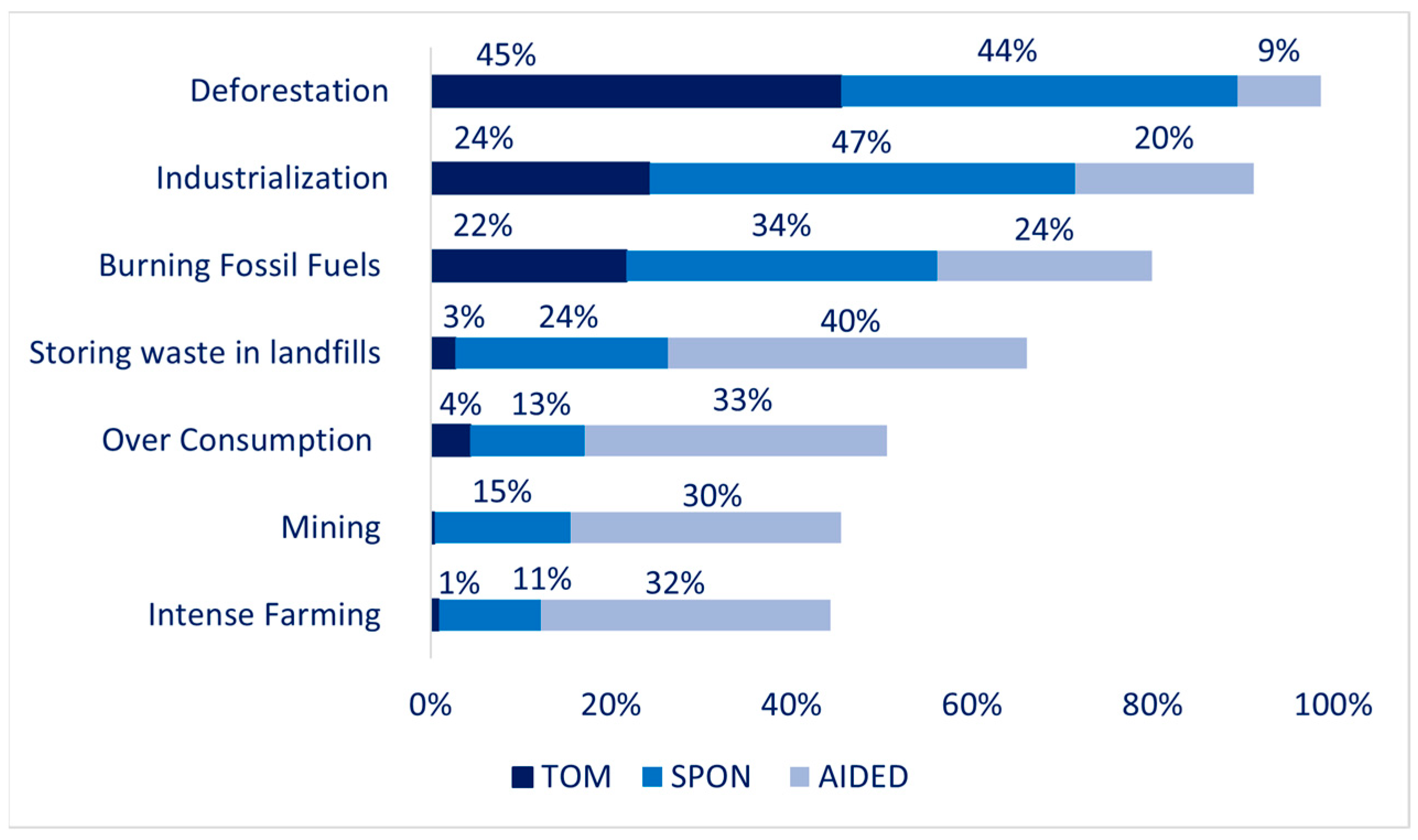
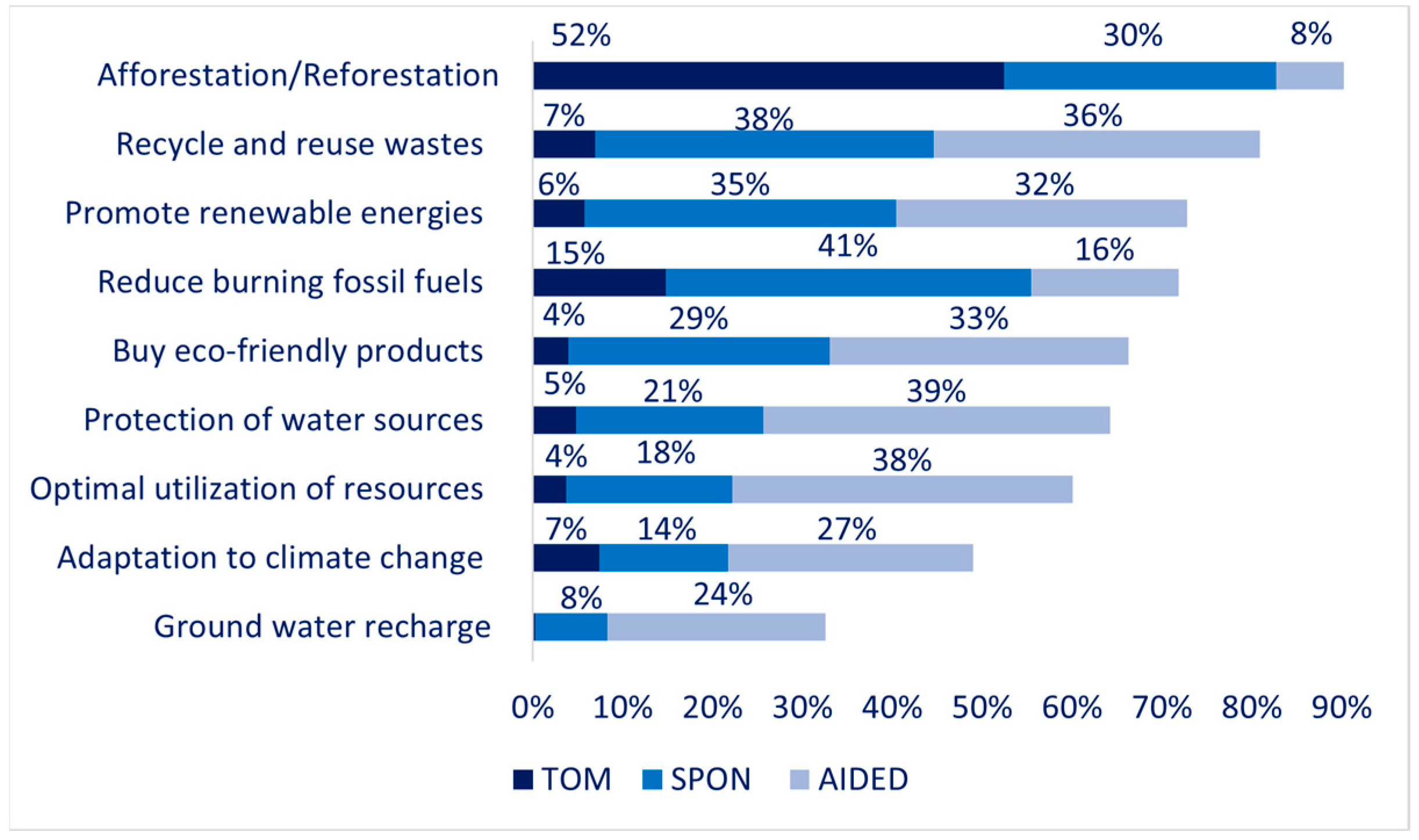
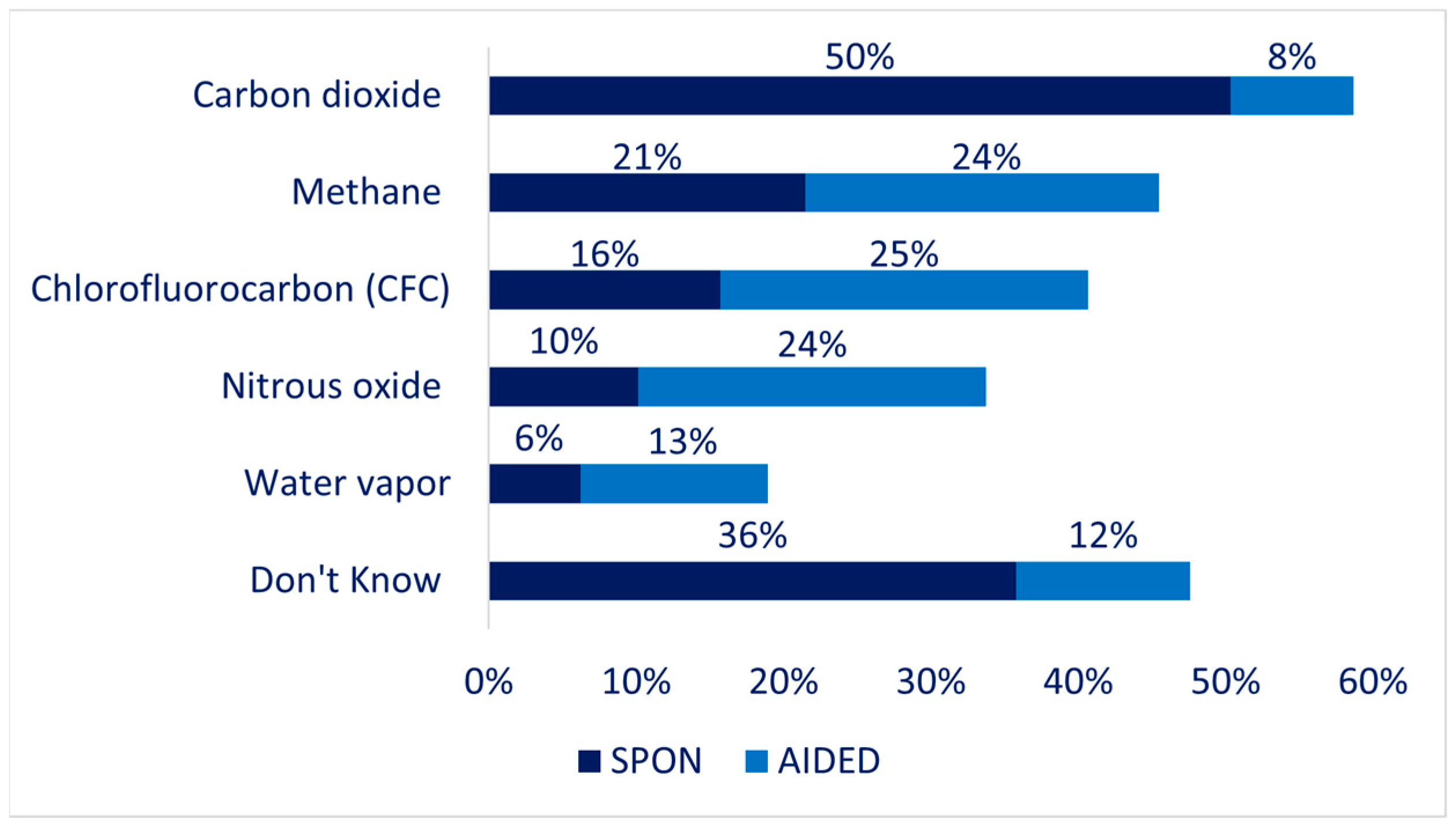
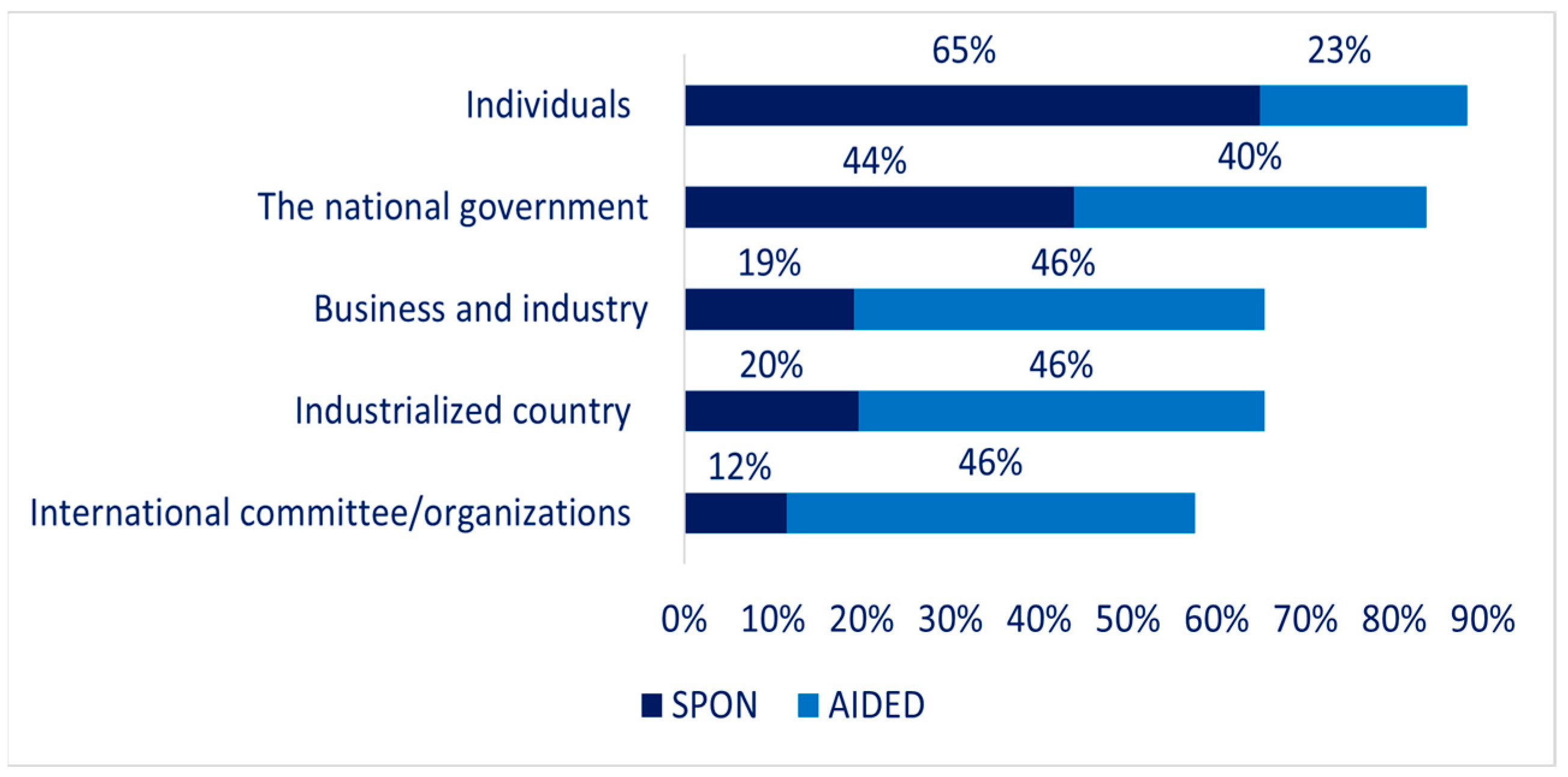
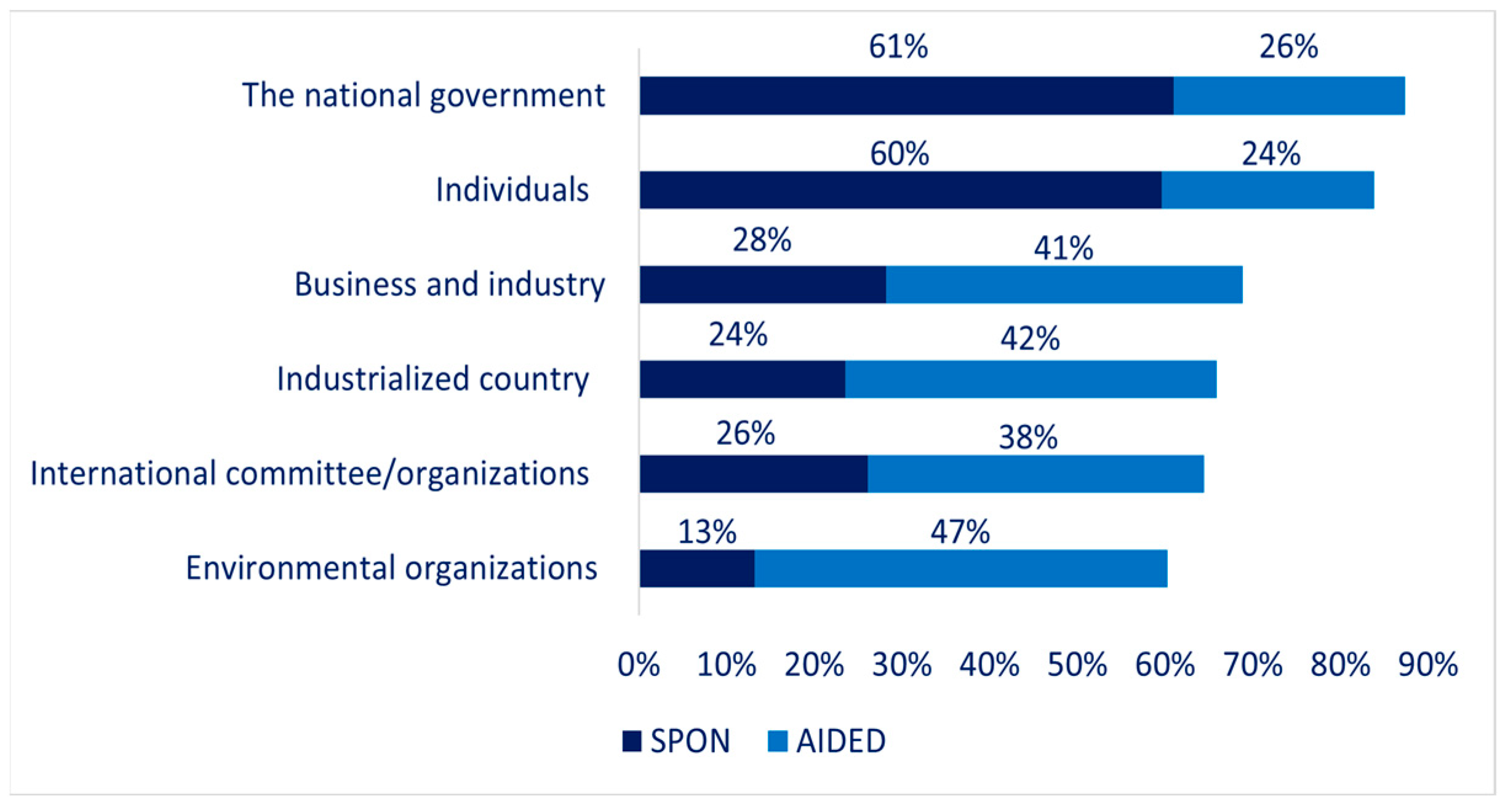



| Variables (References) | Attributes |
|---|---|
| Understanding of Climate Change [19,60,61,62] | Severe hot and cold waves, changes in rain (precipitation), severe droughts, flooding, rising sea levels, changes in plant growth, water scarcity, declining biodiversity, snow melting, increase in vector-borne diseases |
| Understanding on causes of climate change [62,63,64,65] | Burning fossil fuels, deforestation, storing waste in landfills, industrialization, intense farming, mining, overconsumption |
| Understanding the mitigation measures of climate change [63,66] | Afforestation, reducing burning fossil fuels, promoting renewable energies, buying eco-friendly products, recycling and reusing waste, optimal utilization of resources, adaptation to climate change, protection of water resources, and groundwater recharge |
| Greenhouse gases [67,68] | Carbon dioxide, methane, nitrous oxide, water vapor, chlorofluorocarbon |
| Accountable for climate change [69] | International Committee, the national government, industrialized country, business and industry, individuals |
| Responsible for tackling climate change [70] | International Committee, the national government, industrialized countries, business and industry, individuals, environmental organizations |
| Government action [63,65,66] | Awareness program, adaptation policies, protect key ecosystems, support small agricultural producers, promote green energy, carbon taxes |
| Responsible for tackling climate change [70] | International Committee, the national government, industrialized countries, business and industry, individuals, environmental organizations |
| Individual action [19,61,63,71] | Save energy at home, walk, bike, or take public transport, throw away less food, reduce, reuse, repair, recycle, switch to an electric vehicle, and awareness among friends and family |
| Media [61,71] | Television, radio, newspaper, word of mouth, social media, online media, internet search, specialist publication, government agencies |
| Variables | Categories | Frequency | Percentage (%) |
|---|---|---|---|
| Age | 18–25 | 115 | 26.56 |
| 26–35 | 93 | 21.48 | |
| 36–45 | 76 | 17.55 | |
| 46–55 | 62 | 14.32 | |
| Above 55 | 87 | 20.09 | |
| Gender | Female | 220 | 50.81 |
| Male | 213 | 49.19 | |
| Education | No formal education | 21 | 4.85 |
| Primary education | 58 | 13.39 | |
| Secondary school | 82 | 18.94 | |
| Bachelor’s level | 186 | 42.96 | |
| Masters level | 86 | 19.86 | |
| Occupation | Unemployed | 59 | 13.63 |
| Student | 69 | 15.94 | |
| Self-employed | 62 | 14.32 | |
| Retired | 20 | 4.62 | |
| Full-time employed | 108 | 24.94 | |
| Part-time employed | 34 | 7.85 | |
| Homemaker | 71 | 16.40 | |
| Casual labor/odd jobs | 10 | 2.31 |
| Demographics | Pearson χ2 | p value | Hypothesis Test |
|---|---|---|---|
| Age | 56.2638 | <0.001 | Supported |
| Gender | 6.0217 | 0.111 | Not Supported |
| Education | 56.5538 | <0.001 | Supported |
| Occupation | 66.2961 | <0.001 | Supported |
| Demographics | Pearson χ2 | p Value | Hypothesis Test | |
|---|---|---|---|---|
| Age | Flooding | 13.93 | 0.008 | Supported |
| Severe hot and cold waves | 25.14 | <0.001 | Supported | |
| Change in rain precipitation pattern | 2.50 | 0.644 | Not Supported | |
| Gender | Flooding | 2.74 | 0.097 | Not Supported |
| Severe hot and cold waves | 1.18 | 0.277 | Not Supported | |
| Change in rain precipitation pattern | 1.020 | 0.321 | Not Supported | |
| Education | Flooding | 9.42 | 0.051 | Not Supported |
| Severe hot and cold waves | 25.65 | <0.001 | Supported | |
| Change in rain precipitation pattern | 4.63 | 0.327 | Not Supported | |
| Occupation | Flooding | 8.53 | 0.288 | Not Supported |
| Severe hot and cold waves | 21.46 | 0.003 | Supported | |
| Change in rain precipitation pattern | 10.72 | 0.151 | Not Supported |
| Demographics | Causes | Pearson χ2 | p Value | Hypothesis Test |
|---|---|---|---|---|
| Age | Deforestation | 12.73 | 0.013 | Supported |
| Industrialization | 4.69 | 0.321 | Not Supported | |
| Burning fuels | 15.24 | 0.004 | Supported | |
| Gender | Deforestation | 0.18 | 0.670 | Not Supported |
| Industrialization | 1.18 | 0.277 | Not Supported | |
| Burning fuels | 3.36 | 0.067 | Not Supported | |
| Education | Deforestation | 24.46 | <0.001 | Supported |
| Industrialization | 3.27 | 0.513 | Not Supported | |
| Burning fuels | 10.70 | 0.030 | Supported | |
| Occupation | Deforestation | 6.86 | 0.443 | Not Supported |
| Industrialization | 22.70 | 0.002 | Supported | |
| Burning fuels | 19.60 | 0.006 | Supported |
| Demographics | Reduction Factor | Pearson χ2 | p Value | Hypothesis Test |
|---|---|---|---|---|
| Age | Afforestation | 4.27 | 0.370 | Not Supported |
| Recycle and reuse waste | 8.23 | 0.083 | Not Supported | |
| Promote renewable energies | 18.67 | 0.001 | Supported | |
| Gender | Afforestation | 0.98 | 0.323 | Not Supported |
| Recycle and reuse waste | 4.47 | 0.034 | Supported | |
| Promote renewable energies | 0.92 | 0.336 | Not Supported | |
| Education | Afforestation | 8.6 | 0.072 | Not Supported |
| Recycle and reuse waste | 8.4690 | 0.076 | Not Supported | |
| Promote renewable energies | 13.53 | 0.009 | Supported | |
| Occupation | Afforestation | 10.13 | 0.181 | Not Supported |
| Recycle and reuse waste | 11.71 | 0.110 | Not Supported | |
| Promote renewable energies | 17.13 | 0.017 | Supported |
Disclaimer/Publisher’s Note: The statements, opinions and data contained in all publications are solely those of the individual author(s) and contributor(s) and not of MDPI and/or the editor(s). MDPI and/or the editor(s) disclaim responsibility for any injury to people or property resulting from any ideas, methods, instructions or products referred to in the content. |
© 2025 by the authors. Licensee MDPI, Basel, Switzerland. This article is an open access article distributed under the terms and conditions of the Creative Commons Attribution (CC BY) license (https://creativecommons.org/licenses/by/4.0/).
Share and Cite
Shrestha, R.; Kadel, R.; Shakya, S.; Nyachhyon, N.; Mishra, B.K. Awareness and Understanding of Climate Change for Environmental Sustainability Using a Mix-Method Approach: A Study in the Kathmandu Valley. Sustainability 2025, 17, 2819. https://doi.org/10.3390/su17072819
Shrestha R, Kadel R, Shakya S, Nyachhyon N, Mishra BK. Awareness and Understanding of Climate Change for Environmental Sustainability Using a Mix-Method Approach: A Study in the Kathmandu Valley. Sustainability. 2025; 17(7):2819. https://doi.org/10.3390/su17072819
Chicago/Turabian StyleShrestha, Ramesh, Rajan Kadel, Shreeya Shakya, Nishna Nyachhyon, and Bhupesh Kumar Mishra. 2025. "Awareness and Understanding of Climate Change for Environmental Sustainability Using a Mix-Method Approach: A Study in the Kathmandu Valley" Sustainability 17, no. 7: 2819. https://doi.org/10.3390/su17072819
APA StyleShrestha, R., Kadel, R., Shakya, S., Nyachhyon, N., & Mishra, B. K. (2025). Awareness and Understanding of Climate Change for Environmental Sustainability Using a Mix-Method Approach: A Study in the Kathmandu Valley. Sustainability, 17(7), 2819. https://doi.org/10.3390/su17072819









